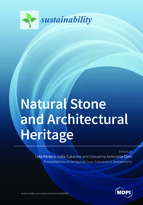Natural Stone and Architectural Heritage
A special issue of Sustainability (ISSN 2071-1050). This special issue belongs to the section "Tourism, Culture, and Heritage".
Deadline for manuscript submissions: closed (20 June 2019) | Viewed by 53429
Special Issue Editors
Interests: natural stones; architectural heritage; characterization of rocks; natural hazards related to stones; natural radioactivity; fibrous minerals
Special Issues, Collections and Topics in MDPI journals
Interests: architectonic heritage; stone degradation; stone wastes; natural raw materials
Interests: circular economy; sustainable mining; raw materials; mining and quarrying; environmental engineering
Special Issues, Collections and Topics in MDPI journals
Special Issue Information
Dear Colleagues,
The working group on Heritage Stones has been growing in the last ten years and it has become obvious that a Special Issue presenting new stones that have been used in the construction of the architectural heritage is demanded. Heritage Stones are those stones that have special significance in human culture. Examples include some very important stones that have been either neglected because they are no longer extracted, or stones that have great significance in commercial terms, but knowledge of their national and/or international heritage has not been well documented.
The aim of this issue is to spread awareness of architectural heritage around the world, and the natural stones that have been used in its construction. Also the need to preserve historical quarries that once provided the source of such stones. Historical quarries are linked to regional culture and traditions. Today very often, due to improved transportation and infrastructure, or globalization that leads to imports of exotic ornamental stones, they lie idle. Because the specific technical and aesthetical characteristics of heritage stones, that have lasted for centuries, these historical quarries should be preserved to be able to use the stone for proper restoration of monuments and historical buildings to avoid negative actions that can be observed in many places in the restoration of buildings, some times part of World Heritage sites.
This is why we invite you to submit your research related to natural stones and heritage, to build an exciting and very interesting Special Issue that will serve as awareness about the importance of natural stones in the architectural heritage.
Prof. Dr. Dolores Pereira
Prof. Dr. Lidia Catarino
Dr. Giovanna Antonella Dino
Guest Editor
Manuscript Submission Information
Manuscripts should be submitted online at www.mdpi.com by registering and logging in to this website. Once you are registered, click here to go to the submission form. Manuscripts can be submitted until the deadline. All submissions that pass pre-check are peer-reviewed. Accepted papers will be published continuously in the journal (as soon as accepted) and will be listed together on the special issue website. Research articles, review articles as well as short communications are invited. For planned papers, a title and short abstract (about 100 words) can be sent to the Editorial Office for announcement on this website.
Submitted manuscripts should not have been published previously, nor be under consideration for publication elsewhere (except conference proceedings papers). All manuscripts are thoroughly refereed through a single-blind peer-review process. A guide for authors and other relevant information for submission of manuscripts is available on the Instructions for Authors page. Sustainability is an international peer-reviewed open access semimonthly journal published by MDPI.
Please visit the Instructions for Authors page before submitting a manuscript. The Article Processing Charge (APC) for publication in this open access journal is 2400 CHF (Swiss Francs). Submitted papers should be well formatted and use good English. Authors may use MDPI's English editing service prior to publication or during author revisions.






